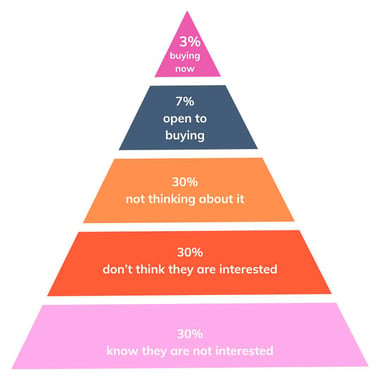The Economics of Cold Calling - Opening The Black Box (Part 3)
An Actionable Model For Cold Calling Efficacy
Yesterday, we talked about how a detachment from the process as well as a lack of rigor in how sales executives think about cold calling result in the wrong things getting measured, with the downstream effect of the wrong outcomes transpiring.
Today, we’re going to demystify the black box by building a model that explicates upon the major leverage points inside every outbound cold calling program, as well as understand the mechanisms by which to pull these levers.
First, the Four Legged Stool
As the outbound manager at Apex Revenue, I would always tell clients to conceptualize our work together as the crafting of an outbound cold calling engine that looks suspiciously like a four legged stool.
The legs of the stool are as follows:
List - WHO you’re targeting
Message - WHAT you’re saying to them
Rep - HOW the rep is executing the messaging
Follow-Up - WHEN to take next steps with the prospects, as well as whether a professional seller follows up or a BDR
We’ll circle back to the stool after talking about the leverage points and the associated thresholds.
Your Metrics
Connect Rate - The ratio of dials: verified pick ups (I.E: The person on the other end is who the rep intends to speak to)
Completion Rate - How often a rep is able to complete a pitch and get enough qualifying information from a prospect to bucket as either a Yes, No, Not Me or Not Now
Activation Rate - How often a prospect that has heard a pitch opts in to either further information OR a meeting
Meeting Scheduled Rate - How often a prospect elects to take a meeting as a next step
The attentive will notice a linear trend - as you progress down the funnel, each leg of the stool remains a key lever. There is an obvious implication but also a less obvious one. The former is that you must solve the right problems in the right order, the latter is that even doing so does not guarantee that the problems are solved for good.
With the rudiments of the model laid out and the benchmarks for success established, we will now break down common colloquial expressions of ineffective cold calling (a polite description of what is more commonly called “a complaint”)
Translating and Troubleshooting Cold Calling Woes As Expressed By Common Complaints:
“Nobody picks up the phone”
Problem Restated in Actionable Terms: Poor or Acceptable Connect Rate
Lever: List
Part 1 touched on this lever from an anecdotal perspective, but it should go without saying that if “nobody picks up the phone” is meaningful commentary on a connect rate that falls within the “Poor” or even “Acceptable” benchmarks, then the first thing you want to invest in is data enrichment and channel validation (Phone Ready Leads is the Platinum Standard here). I won’t rehash the importance of data enrichment and validation (see Part 1 for this) but assuming a set of outcomes at a given connect rate, let’s call it X, means that if you change nothing else in the system but can triple your connect rate to 3X, you’ll accelerate your speed to outcome by the same proportion. There’s few other places in your calling funnel you can immediately get a 300% lift, so this is always the first place to start.
“My reps get hung up on before they can even get our message out”
Problem Restated in Actionable Terms: Poor or Acceptable Completion Rate
Levers: List & Message
You’ll notice that both list and message are levers for this woe, as WHERE your prospects terminate the conversation will determine which lever has more remedial impact
If your reps are getting blown out BEFORE they get to the pitch (AKA hang at opener), then the way you’re opening the conversation is causing too much dysfunction (H/T Justin Middleton for the term). I generally loathe to talk about openers, but first impressions DO matter, and in most cases you simply want to get conversation going back and forth. Too many marketing-written scripts go directly into features and benefit vomit that give prospects no reason to reciprocate interaction.
When identifying and diagnosing this specific challenge, it’s vital to keep an eye on longer time series data (ideally 14+ days) as opposed to short term completion rate - when you’re in the seat, some days it feels like ”everybody is hanging up” but averages happen in large numbers, and the reality of interruptive communication is that you simply will catch people at the wrong time. Overreacting to short term fluctuations can cause more problems than it solves.
If your reps are delivering pain points and you lose prospects before they’ve given sufficient information for bucketing (AKA hang mid pitch), then either your paints aren’t resonating with the right person (a bottleneck at Message) or you’ve got the right pains and you’re talking to the wrong person (a bottleneck at List)
As a more granular point to evaluate the above, it’s worth keeping an eye on the percentage of people who say they’re not a stakeholder in the problem (AKA: “Not Me”) and also dive deeper when they give you enough information to identify the right stakeholder (AKA: “Referred”). Although these are completed conversations, high percentages of these numbers may indicate your issues lie with targeting rather than messaging. If, on the other hand, a high percentage of your completions are “Not Interested”, then it’s likely messaging is the culprit.
“Prospects seem to always tell us that now isn’t the right time to take a look at our solution, that they already have something in place or that they’re ‘all set’”
Problem Restated in Actionable Terms: Poor or Acceptable Activation Rate
Levers: Message, Rep
Now we’re getting into the demand generation side of cold calling. First, some good news: If a prospect is able to make this determination, you’ve eliminated targeting/list as a possible source of woes. Pat yourself on the back - you’re at least in the right ballpark, and now it’s about generating interest
This is more art than science, but listen to call recordings and see how enthusiastically prospects are relating to the pain points in the pitch (this is why it’s vital that your pitch be not a series of features and benefits, but a bellwether for how closely your prospect feels related to). If you’re being met with indifference, then you’ve got some work to do on messaging. Tactically, addition of social proof is something that often moves the needle here.
If the above box is checked but activation rate is still sub-standard, then there’s a good chance your reps are falling apart during the post-pitch open dialogue. This is probably the hardest part of a call to script, but SPIN is a great reference tool here. If you can walk through a logical SPIN framework, implicit to that conversation is shared understanding for next steps.
Additional Consideration: This is the bucket with the highest rate of false positives, as reps are pre-disposed to getting happy ears and activating anybody who says “send me some information”
It’s first and foremost worth differentiating that we are talking here about a prospect who has heard the pain points, explicated that they relate to them and that they would be open to evaluating a solution, and NOT a blow-off “information request” - which is typically characterized by its occurrence early in the call.
As a useful guideline, consider here the 4i’s (h/t Justin Middleton once more) Interest, Intent, Intrigue, (Request for) more Information
Another useful bellwether: If the prospect isn’t actively participating in the conversation - characterized by questions about how the solution works, then this is probably a blow-off rather than a solid activation.
“Prospects say they’re interested, but nobody will take a meeting and just requests information instead”
Problem Restated In Actionable Terms: Poor Meeting Scheduled Rate
Levers: Rep, Follow-Up
Curiously, this is the bucket that’s given the most focus by leadership, but which matters the least. Sure, you ultimately need meetings to drive outcomes, but for the most part somebody who’s a genuine activation will take a meeting if it’s their personality (as long as the rep asks). If it isn’t, trying to force the meeting vs. conforming to their buying preferences is more likely to alienate than yield positive outcomes
Joey Gilkey says it best: “There are two different kinds of buyers on Amazon - the first searches for what they need, sees a few thousand reviews at a 4.7 star average, hits ‘buy now’ and goes about their life. Those are your meeting bookers. Then there’s the buyer that adds competing products to cart, reads the reviews, goes to YouTube to watch product demos etc. Those are your activated leads.”
There’s some tactical strategies around asking for the meeting multiple times, but for the most part your biggest lift here will be working with your professional sellers on the back-end to convert them. More on that in Part 4.
Gentle Reminder: Averages Happen In Statistically Significant Large Sample Sizes
With troubleshooting steps explicated, now is a good time to reference Chet Holmes’ Buyer’s Pyramid (pictured below) as a grounding reference to avoid overoptimize around short term variance.
When you’re doing outbound, approximately 80-90% of the people you talk to won’t be thinking about your solution at all, with at least 60% of them likely negatively pre-disposed.
Capturing the top 10% should be a gimme (they’re already problem aware and seeking solutions), and if you’re not capturing those then you have real issues, but the real battle is over the next tier: The 30% not thinking about it.
Interestingly This is where the myopic obsession with meetings among sales leadership causes dysfunction: If only 10% of your market is open to buying at any given time, then pounding the table and demanding reps attempt to force the other 90% of the market into meetings is a giant waste of time, money and energy while damaging brand reputation.
Outbound is a long term game, no matter what execs under pressure to produce immediate results want.
Don’t believe me? Let’s do the Math of Market Domination courtesy of The Godfather of Outbound Chris Beall:
The typical replacement or repurchase cycle for most B2B products and services is around 3 years (ConnectAndSell)
If we divide a 3-year cycle into quarters, we get 12 quarters total.
Consequently, the probability that a company is within the buying window is 8.33% (1/12 - let’s call it 8.5%)
If this had you scratching your head, to put it another way: In any given quarter, roughly 1/12th of the market (or about 8.5%) will be actively considering a purchase or replacement.
This information has important implications for your outbound machine at large:
The Importance of Follow Up: I’m teasing Part 4 here, but if 8.5% of your market is in the buying window at any given time, but you don’t know when that might be, then you need to be talking to your prospects at LEAST quarterly. Trying to force them into a meeting now, when they’re not in the buying window, does nothing but reduce the probability that they will talk to you in the future when they are. Don’t be shortsighted.
Market Coverage: 8.5% of your market is in the buying window any given quarter, but knowing that and knowing WHICH COMPANIES are in the buying window is another question entirely. No, this does not mean that you need to purchase an “intent data” platform to extrapolate from spurious data points, but rather that a commendable goal should be to have conversations across your market so that you can map that intel first hand.
Long-term perspective: Let’s do some back of the envelope math here. If 8.5% of your market is in the buying window and you capture 50% of them, you now have 4.75% of the market. Assuming a linear trend, it’ll take you 11.76 quarters, or a little under 3 years to achieve 50%+ market share, AKA market dominance
For VPs of Sale who have an average tenure of under a year, 3 years can sound like an eternity, but the reality is the market is under no obligation to conform to anybody’s demands, and forcing short term outcomes are more likely to catabolize long term success than realize expedited results.

In the next part, we’ll talk about hand-off and the role professional sellers play in an effective outbound machine. The job is far from done, and in some ways…it’s only beginning.
Special thanks to Justin Middleton, Joey Gilkey, Ryan Reisert, Chris Beall and Zeke Lucas for serving as either explicit or implicit collaborators on this work. “If I have seen further it is by standing on the shoulders of Giants” - Isaac Newton







